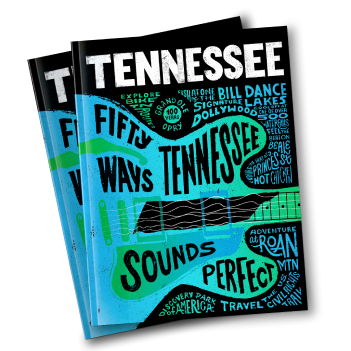Country music runs deep in Tennessee’s roots, and the Country Music Pathway is the perfect way to explore its rich history. With over 20 landmark locations, this pathway invites fans to experience the places where the genre’s legends were made—from Nashville’s Ryman Auditorium and Grand Ole Opry to Memphis' Graceland to hidden gems across the state.


Birthplace of Country Music Museum
In 1927, producer Ralph Peer set up a makeshift studio on the third floor of an old hat warehouse. With two sound engineers and a Western Electric microphone, he spent 12 days recording 76 songs from 19 different artists. Today, those recordings are known as the Bristol Sessions — the “big bang of country music.” They helped launch the careers of stars like the Carter Family and Jimmie Rodgers, and heavily influenced country music as we know it. Today the Bristol Sessions live on at the Birthplace of Country Music Museum. See and hear history come to life with rare audio recordings, interactive exhibits, theater experiences, and iconic artifacts, like Jimmie Rodgers’ Martin guitar.

Historic Tennessee Theatre
When the Tennessee Theatre opened in 1928, people called it “the South’s most beautiful theatre.” Since then, this breathtaking Knoxville building has served as a single-screen movie theater, a world-class performing arts venue, and is now the official state theater of Tennessee. Today you can see the theater in action during a concert, symphony performance or a Broadway show. Or, check its schedule for an Open House tour to get all the behind-the-scenes details of this historic gem.

Cradle of Country Music Walking Tour
Knoxville is one of America’s more dynamically musical cities - remarkable for its part in the development in jazz, blues and rock and roll but critical in the development of what we now call country music. This free, downtown self-guided walking tour explains Knoxville’s ties to Hank Williams, Elvis Presley, Howard Armstrong, Dolly Parton, the Everly Brothers, Roy Acuff, and others. Discover more information about this walking tour by visiting Visit Knoxville's website.

WDVX Blue Plate Special
Continuing in the tradition of Tennessee’s live performance radio shows, WDVX’s “Blue Plate Special” brings a dose of live music to Knoxville every day at noon. Many famous musicians have performed on the Blue Plate stage, but local musicians and new talent are welcome as well. Monday through Thursday the show is held at the Knoxville Visitors Center. On Friday, it moves to Barley’s Taproom and Pizzeria for a larger audience. Come experience the magic of live music for yourself.

Dolly Parton Statue
Born in a one-room cabin on the banks of the Little Pigeon River, Dolly Parton grew up as the fourth of 12 children. She showed musical talent from a young age and was performing in front of live audiences by the age of 10. After graduating from high school, she moved to Nashville and went on to become one of the biggest stars in country music. The statue stands in downtown Sevierville as a tribute to her achievements and a “thank you” for her generosity to her East Tennessee community. Since its creation, it has become a popular spot for photographs and selfies. Come see the statue in all its glory.

Dollywood
Dolly Parton's story is one of big dreams and incredible talent. As one of the most successful artists of all time, it is only fitting that she'd have a theme park that bears her name. Visit the park for a day of family fun and entertainment. While you're here, learn more about Dolly's life and various museums and exhibits throughout the park, including a replica of her childhood home.

Songbirds Guitar & Pop Culture Museum
Browse the collection of over 30 rare and vintage guitars which ranges from two ultra-rare Les Paul Goldtop prototypes to Dolly Parton’s very own Fender Acoustasonic. Songbirds also has an unmatched collection of vintage effects pedals and amps that you can actually hear. Gretsch, Gibson, Fender, Marshall, Maestro, and more—all the historic brands are represented throughout the exhibits. Best of all, it’s free!

Ryman Auditorium
When you walk through the doors of the Ryman, you’re on hallowed ground. This is the place where bluegrass captivated an audience and country music became famous. It’s where Johnny Cash first met June Carter, and Hank Williams made his Grand Ole Opry debut with six encores of “Love Sick Blues.” Originally, this building was built for preachers, but today it’s known as the “Mother Church of Country Music.”
Take a tour and experience the history for yourself. When you’re done, cut your own record at the in-house recording studio or take a stroll through the Hatch Show Print gallery, where you can see dozens of one-of-a-kind letterpress posters from past Ryman performances. Don’t forget to check out the Ryman Alley. After a performance at the Ryman, artists would use this alley to slip into Tootsie’s Orchid Lounge and other Lower Broadway honky tonks for a drink. It’s a tradition that continues to this day, making this humble stretch of asphalt some of the most famous in country music history.

Broadway Historic District: Honky Tonk Highway
Known as the “Honky Tonk Highway,” Lower Broadway is lined with famous bars where many music legends first got their start. Spend some time at Tootsie's Orchid Lounge, where icons like Kris Kristofferson, Patsy Cline and Waylon Jennings were once regular customers. Willie Nelson got his first songwriting gig at Tootsie’s, and rumor goes that it’s also where Roger Miller wrote “Dang Me.” Then make your way to Nudie's Honky Tonk, where you can have a drink and learn about the man who gave country music some glamour. Nudie Cohn was a tailor who became famous for designing rhinestone-covered suits.

Country Music Hall of Fame and Museum
With more than 350,000 square feet of gallery and archive space, this museum houses the world’s large collection of country music artifacts from both classic and current artists. You can also visit the Hall of Fame Rotunda to see the inductees of the Country Music Hall of Fame. Before you leave the museum, get your tickets for the RCA Studio B tour. Known as the “Home of 1,000 Hits,” this iconic studio has heard countless musical legends record within its walls. Then, go next door to Hatch Show Print. When the stars of country music needed a poster to announce their upcoming shows, this is where they went. This historic letterpress shop is still working and today, these posters are icons of music history. Smell the ink. Hear the presses. See the one-of-a-kind letterpress prints. Maybe even take one home for yourself. Finally, take a stroll along the Music City Walk of Fame, a tribute to Nashville’s musical heritage and those who have contributed to the world through song.

Musicians Hall of Fame & Museum
Behind every hit song, there are musicians whose names you’ve probably never heard. Take a tour and discover the instruments and people behind some of the greatest recordings of all time. Hear the stories and discover how the Blue Moon Boys, the Nashville “A” Team, the Tennessee Two, and many more helped make music history.

Patsy Cline Museum
Though she was only 30 years old when she died in a plane accident, Patsy Cline is remembered as a music icon. With hit songs like “Crazy” and “I Fall to Pieces,” Cline was one of the first country music artists to successfully cross over into pop music. Today, she’s considered one of the most influential vocalists of the 20th century. Explore never-before-seen artifacts, photos and videos from this legendary songstress’s life, and learn how she helped break down gender barriers in country music, becoming one of the first female artists to headline her own show. After the museum, visit the Patsy Cline Memorial in Camden, just a few hours west of Nashville.

Johnny Cash Museum
In 1954, Johnny Cash moved to Memphis to become a radio announcer. He sold appliances during the day and played music at night. While he never got a job in radio, he did eventually win over producer Sam Phillips and recorded “Hey Porter” and “Cry! Cry! Cry!” at Sun Studio. In the next few years, after the release of “Folsom Prison Blues,” Cash skyrocketed to fame and became one of the best-selling music artists of all time. Learn more about his story and legacy in music at the Johnny Cash Museum, home to the largest collection of Cash artifacts in the world. Then, just a short drive outside of Nashville, visit the site of his former home at the Johnny Cash Historical Marker or pay your respects at his gravesite in Hendersonville. You can also learn the heartbreaking story behind the orchard, a plot of land Cash purchased from his good friend Roy Orbison, at the Roy Orbison Historical Marker.

Gibson Garage
Tucked into the heart of Music City, The Gibson Garage is a must-see, hands-on experience for guitar players and music fans. For well over 100 years, this iconic American company has produced guitars played by multiple generations of music stars and musicians. Try out a guitar, take a lesson, learn about Gibson’s history, or see a live show.

Third Man Records
This independent record label, founded by musician Jack White, opened its first physical location in Nashville in 2009. Take a tour to see the studio-meets-record shop. Be sure to get a look inside the Blue Room — the only venue in the world where artists can still record live shows direct-to-acetate to produce a vinyl master in real time.

The Bluebird Cafe
Though it looks small, this 90-seat music venue has helped launch the careers of some of country’s biggest superstars, including Garth Brooks and Taylor Swift. Famous for an “in the round” show format, The Bluebird brings songwriters to center stage, where they take turns playing and sharing the stories behind their songs. Get your show tickets ahead of time, because these intimate shows sell out quickly.

Grand Ole Opry
Celebrating its 100-year anniversary in 2025, the Grand Ole Opry has been sharing country music with the world one hour at a time. From its first days as the “WSM Barn Dance” to its time at the Ryman Auditorium, the Opry has launched careers and made stars out of those invited to perform on its sacred stage. Take a backstage tour and learn more about the people, places and stories behind the show that made country music famous.
After your tour, take in more Opry history by visiting the WSM Radio Tower and the Edwin Craig Historical Marker at the William R. Snodgrass Tennessee Tower. Then, check out the DeFord Bailey Historical Marker on 12th Avenue and the Birthplace of Minnie Pearl to learn more about two of the show’s iconic stars.

The Hideaway Farm
Located a short drive west of Nashville on I-40, this was the place Johnny Cash used to escape from public life. Now the Hideaway Farm in Lyles (Bon Aqua), TN is a must-stop for anyone interested in knowing more about the man behind the country music icon, as well as the region’s rich history.

Loretta Lynn's Ranch - Event Venue, Campground, Tourist Destination
Visit the ranch owned by music legend Loretta Lynn. Learn about her childhood as a coal miner’s daughter and her journey to becoming one of country music’s biggest stars at the Coal Miner’s Daughter Museum. You can also check out a replica of her childhood home at the Frontier Homestead. Other highlights of the ranch include a grist mill, a replicated coal mine, and a mini theater where visitors can watch a movie about her life.

Carl Perkins Visitor Center
People say there’d be no rock ’n’ roll without Carl Perkins. But without the experiences he had in this house in Tiptonville — and that steady mix of blues, country and gospel he was exposed to here — rock ’n’ roll might sound completely different. See the living room where he’d spend Saturday nights listening to the Grand Ole Opry on his father’s radio. Stand on the porch where he learned blues and gospel on a second-hand guitar from John Westbrook, an African American fieldworker Perkins called “Uncle John.”

Ridgecrest Cemetery
Carl Perkins kicked off his musical career by performing with his brothers at local dances in Jackson. But after hearing Elvis Presley’s debut Sun Records single, “Blue Moon of Kentucky,” he knew he had to be part of what was happening in Memphis. Sam Phillips signed him to Sun in 1954, and Perkins would go on to become a rockabilly icon with songs like “Blue Suede Shoes,” “Matchbox,” and “Everybody’s Tryin’ To Be My Baby.” You can pay tribute to the rock music pioneer by visiting his gravesite at Ridgecrest Cemetery.

Legends of Tennessee Music Museum
Some stories say that long before rock ’n’ roll was recorded in Memphis, it was written and played in Jackson. Discover the stories behind Tennessee music legends like Carl Perkins, Eddy Arnold and Sonny Boy Williamson through carefully curated artifacts and priceless music memorabilia.

Sun Studio
If these walls could talk, they would tell the story of the explosion of rock ’n’ roll. This is where self-taught producer Sam Phillips created a new sound and an impromptu jam session created the “Million Dollar Quartet,” consisting of Carl Perkins, Elvis Presley, Jerry Lee Lewis and Johnny Cash. It’s where Perkins laced up his “Blue Suede Shoes” and Presley became the King.
While you’re on the tour, take a close look at the piano in the studio. You can still see where Lewis stubbed his cigar out on the keys during rehearsal, saying, “Now everyone will know this was the piano Jerry Lee Lewis played.” Stand on the “X” in the center of the room — the very spot where icons like Presley stood while recording.

Elvis Presley’s Graceland
From tours of Elvis’ beloved home, Graceland Mansion, to more than 10 exhibits constantly being refreshed exploring his passions and career at Elvis Presley’s Memphis, guests will be fully-immersed into the life of the King of Rock ‘n’ Roll. In addition, guests can enjoy live concerts at the Soundstage at Graceland, specialty-themed weekends, annual Elvis celebrations, and much more. There is more to see, hear, taste and explore than ever before at Elvis Presley’s Graceland – and now is the perfect time to plan your visit!

Beale Street Brass Notes Walk of Fame
Walk among the legends like Isaac Hayes and Scotty Moore who made Memphis music famous on the Brass Notes Walk of Fame. The first musical note was engraved and dedicated in 1986. Today, there are more than 160.

Beale Street Historic District
There’s a reason Beale Street is known as the “Home of the Blues.” This is where W.C. Handy and his band played to rowdy nightclubs in the early 1920s. Where musicians like B.B. King, Howlin’ Wolf, Louis Armstrong, Muddy Waters and many more helped create a new style of blues. Today you’ll hear live music from all genres pouring out of the neon bars and restaurants into the early hours of the morning. While you’re here, take a stroll past the Pee Wee Saloon Historical Marker and learn about one of the favorite spots of early 20th century blues musicians.
The stories behind country music are waiting for you from Bristol to Memphis. Explore the Country Music Pathway and see the places that inspired the music.
Spring & Summer Festivals in Tennessee
Plan to attend these unique, quirky and family-friendly festivals happening in the spring and summer.



































